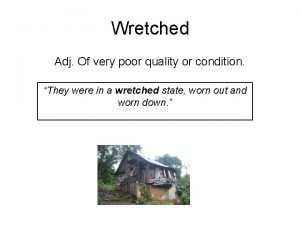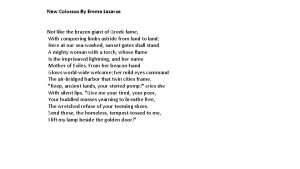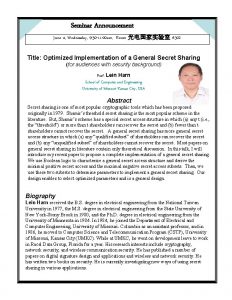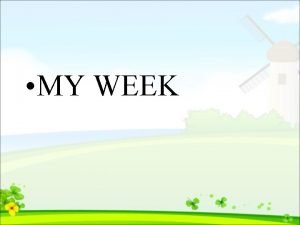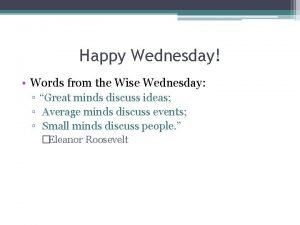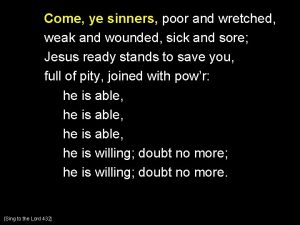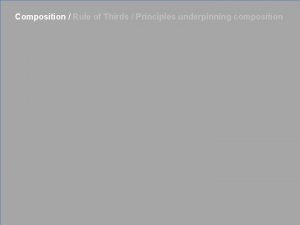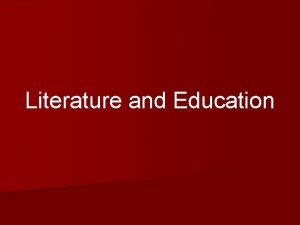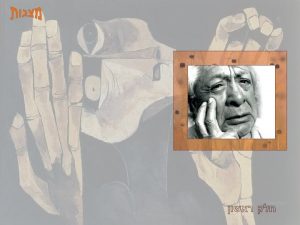AP LITERATURE AND COMPOSITION Its a Wretched Wednesday




![_____ 1. [Inez] wore a white dress, white shoes, a blue gingham apron, and _____ 1. [Inez] wore a white dress, white shoes, a blue gingham apron, and](https://slidetodoc.com/presentation_image_h2/634de45340ba7bab713f06634e6e8103/image-5.jpg)
![E. 1. [Inez] wore a white dress, white shoes, a blue gingham apron, and E. 1. [Inez] wore a white dress, white shoes, a blue gingham apron, and](https://slidetodoc.com/presentation_image_h2/634de45340ba7bab713f06634e6e8103/image-6.jpg)










- Slides: 16

AP LITERATURE AND COMPOSITION “It’s a Wretched Wednesday!” February 26, 2014 Mr. Houghteling

AGENDA Methods of Characterization Review the ALLUSIONS: Jackie Robinson Joe Louis Charles Stewart Parnell Oral reading. HOMEWORK: Read through Chapter 16 (page 124).

Methods of Characterization • What the character does, or how the character acts • Thoughts, feelings, emotions a character has • The physical description of the character TRUST • What the character says • What others say about the character • The direct comments the narrator says about the character or the character’s nature SKEPTICISM

Methods of Characterization A. What the character does, how the character acts B. Thoughts, feelings, or emotions a character has C. What the character says D. What others say about the character E. How the character looks (physical description, manner of dress) F. The narrator can make direct comments about the character’s nature.
![1 Inez wore a white dress white shoes a blue gingham apron and _____ 1. [Inez] wore a white dress, white shoes, a blue gingham apron, and](https://slidetodoc.com/presentation_image_h2/634de45340ba7bab713f06634e6e8103/image-5.jpg)
_____ 1. [Inez] wore a white dress, white shoes, a blue gingham apron, and a kerchief on her head. _____ 2. I clamped my jaws so tight the veins in my neck felt as if they would burst. I wanted to scream at my aunt; I was screaming inside. _____ 3. “You going with us up the quarter, ” my aunt said, as though I hadn’t said a word. “You going up there with us, Grant, or you don’t sleep in this house tonight. ” _____ 4. Jefferson became frightened. The old man was still alive. He had seen him. He would tell on him. _____ 5. “Do you see anyone here who could plan a murder, a robbery, can plan—can plan anything? . . . No, gentlemen, this skull here holds no plans.
![E 1 Inez wore a white dress white shoes a blue gingham apron and E. 1. [Inez] wore a white dress, white shoes, a blue gingham apron, and](https://slidetodoc.com/presentation_image_h2/634de45340ba7bab713f06634e6e8103/image-6.jpg)
E. 1. [Inez] wore a white dress, white shoes, a blue gingham apron, and a kerchief on her head. A, B 2. I clamped my jaws so tight the veins in my neck felt as if they would burst. I wanted to scream at my aunt; I was screaming inside. C 3. “You going with us up the quarter, ” my aunt said, as though I hadn’t said a word. “You going up there with us, Grant, or you don’t sleep in this house tonight. ” B 4. Jefferson became frightened. The old man was still alive. He had seen him. He would tell on him. C 5. “Do you see anyone here who could plan a murder, a robbery, can plan—can plan anything? . . . No, gentlemen, this skull here holds no plans.

Methods of Characterization A. What the character does, how the character acts B. Thoughts, feelings, or emotions a character has C. What the character says D. What others say about the character E. How the character looks (physical description, manner of dress) F. The narrator can make direct comments about the character’s nature.

_____ 6. Bear had been drinking, and his eyes were glossy, he walked unsteadily, grinning all the time as he continued around the counter. _____ 7. Her large, dark face showed all the pain she had gone through this day, this past weekend. No. The pain I saw in that face came from many years past. _____ 8. The whiskey burned him like fire—his chest, his belly, even his nostrils. _____ 9. I figured that’s where most of their money went, on those gold teeth, that perfume, and payment on the new white Cadillac that Joe had parked before the door. But they were good people, both of them. _____ 10. “And I teach what the white folks around here tell me to teach—reading, writing, and ‘rithmetic. They never told me how to keep a black boy out of a liquor store …Tante Lou, Miss Emma, Jefferson is dead. …He’s dead now. And I can’t raise the dead. All I can do is try to keep the others from ending up like this—but he’s gone from us. ”

F, E, A 6. Bear had been drinking, and his eyes were glossy, he walked unsteadily, grinning all the time as he continued around the counter. D 7. Her large, dark face showed all the pain she had gone through this day, this past weekend. No. The pain I saw in that face came from many years past. F 8. The whiskey burned him like fire—his chest, his belly, even his nostrils. D 9. I figured that’s where most of their money went, on those gold teeth, that perfume, and payment on the new white Cadillac that Joe had parked before the door. But they were good people, both of them. C 10. “And I teach what the white folks around here tell me to teach—reading, writing, and ‘rithmetic. They never told me how to keep a black boy out of a liquor store …Tante Lou, Miss Emma, Jefferson is dead. …He’s dead now. And I can’t raise the dead. All I can do is try to keep the others from ending up like this—but he’s gone from us. ”

Grant as teacher (33 -41) Ch. 5 • What did we learn about Grant as teacher of the plantation children? (Characterization) • What do we learn about the plantation society? (Setting)

Waiting for Sam Guidry (42 -50) • What evidence can you cite about the tyranny of white oppression as demonstrated in Chapter 6?

Dr. Joseph (51 -58) • Why does Ernest J. Gaines include the chapter of the superintendent of school visiting the plantation school? (Author’s purpose) • What comparison does Grant make about Dr. Joseph’s treatment of the children? Cite your evidence. (historical background)

The old men and Matthew Antoine (59 -66) • What is the “vicious circle” Grant describes? (62) (historical background) • Who is Matthew Antoine, and why is he so important to Grant and, in extension, to our understanding of the novel? (Characterization)

The first visit with Jefferson (67 -74) • How did you react to Gaines’s description of the visit between Miss Emma, Tante Lou, Grant, and Jefferson?

HOMEWORK • Read through page 124 (Chapter 16).

Jackie Robinson steals home… http: //www. youtube. com/watch? v =6 XY-Xsh. Gh. MU
 Wretched verb
Wretched verb Emma lazarus quote
Emma lazarus quote Properties of solid liquid and gas
Properties of solid liquid and gas Ap literary terms
Ap literary terms Monday tuesday wednesday thursday friday calendar
Monday tuesday wednesday thursday friday calendar Wednesday evening prayer
Wednesday evening prayer Wednesday seminar
Wednesday seminar 2019 ib boundaries
2019 ib boundaries Web analytics wednesday
Web analytics wednesday Again
Again Good morning happy february
Good morning happy february My favourite day is saturday
My favourite day is saturday Skinny wednesday
Skinny wednesday Flmsg download
Flmsg download Sunday monday tuesday thursday friday saturday
Sunday monday tuesday thursday friday saturday Wise wednesday
Wise wednesday Happy wednesday march
Happy wednesday march
